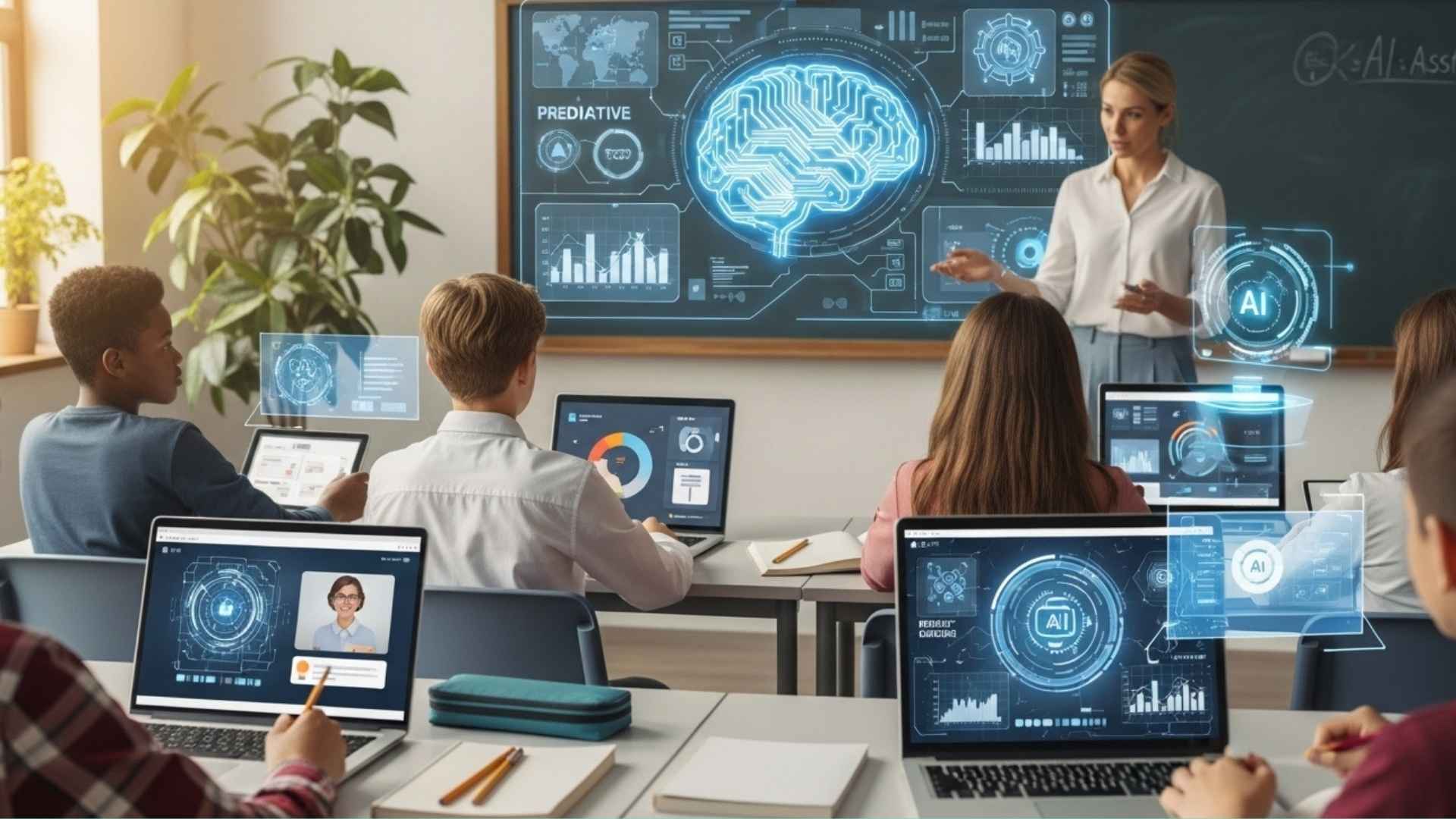This technology can analyze big data and personalize learning. It can also improve operations and achieve better results.
By using machine learning, scientists and administrators can solve complex challenges more efficiently and accurately. This is to create opportunities for every learner to succeed.
What is Machine Learning in Education?
Machine learning is a technology that helps automate processes in the education sector, personalize student experiences, and improve operations.
This technology can adapt to individual learning needs and organizational challenges by extracting insights from algorithms and data. This can transform traditional education.
The essence of machine learning is to use data to identify patterns and improve decision-making processes. This includes assessing student performance, predicting educational outcomes, and adapting instructional materials to enhance the learning experience.
In addition to students, machine learning can also improve teacher effectiveness and simplify administrative tasks. It can also improve long-term strategic planning for organizations. As the use of machine learning increases, its potential to drive equity and innovation in education will become more apparent, while also ensuring more relevant learning experiences.
11 Benefits of Machine Learning in Education
Machine learning is creating significant opportunities for students, educators, and administrators to reimagine the educational experience. The technology can be used to deliver personalized learning, improve operations, and better resource availability.
By understanding how this technology supports teaching and learning, schools can harness the full potential of machine learning. From streamlining processes to improving equity, the possibilities are endless and the impact is immense.
1. Personalized Learning Experiences
Machine learning can analyze students’ strengths, weaknesses, and preferences and create personalized learning paths.
This system can assess students’ learning styles and identify areas of strength and areas where they need to be reinforced. Adaptive learning platforms can use this information to recommend resources, speed up lessons, or reframe concepts to make them more understandable to students.
Personalization benefits students by making learning more engaging and effective. Teachers can also see more clearly where they need to step in. This targeted approach ensures that every student gets the support they need to succeed academically.
2. Better Learning Outcomes
Machine learning can provide insights into student performance, which can lead to better educational outcomes.
Predictive analytics can assess past performance and interactions to identify factors that lead to success or struggle. For example, if students consistently score low on quizzes, machine learning tools can recommend specific content reviews or teaching strategies.
This data-driven approach can help teachers refine their methods and make teaching more effective. Students will also benefit from better support and guidance, which can improve comprehension, retention, and long-term academic success.
3. Improving operational efficiency
Educational institutions often face challenges in managing resources effectively. Machine learning can improve administrative processes such as course scheduling, resource allocation, and campus facilities maintenance. Algorithms can streamline operations so that resources are used where they are most effective.
These efficiencies help faculty and administrators focus more on their core responsibilities. Students also benefit indirectly by receiving more effective learning experiences.
4. Reduce administrative workload
Machine learning automates time-consuming administrative tasks such as recording student attendance, grading assignments, and data entry. By outsourcing repetitive tasks to intelligent systems, educators can focus more on teaching and learning.
For example, automated systems can analyze submitted essays for grammatical errors, plagiarism, or whether they meet the objectives of the assignment. Such automation can not only speed up routine tasks, but also maintain accuracy and consistency.
5. More accurate assessment and grading
Repetitive processes and human error are common challenges in education. Machine learning reduces these problems by assessing student work against consistent standards. It can objectively grade essays, quizzes, and even complex projects, resulting in more fair results.
This level of accuracy gives students confidence in the assessment process and allows educators to focus more on the quality of teaching. Over time, this fairness in grading can encourage better effort and engagement from students.
6. Making Online Learning Easier
Machine learning can create more accessible and unbiased online learning platforms. Algorithms can analyze different learning needs and adapt teaching methods accordingly.
This ensures that every learner, no matter where they are, can participate in high-quality education. With the emergence of intelligent chatbots, AI-backed tutors, and real-time feedback systems, virtual learning environments are becoming more supportive and effective. These tools can bring equity to education and increase learning opportunities beyond traditional classrooms.
7. Faster Research and Data Analysis
Academic research requires extensive data collection and analysis, which is where machine learning excels. Algorithms can process large amounts of data instantly and identify patterns, relationships, or anomalies. This capability reduces the time it takes to conduct research, so scholars and students can gain insights faster.
In fields such as scientific studies or social research, machine learning makes it easier to model complex data. This technology allows researchers to do more with the data and make sense of it.
8. Improved Admissions Process
Admissions offices often have to deal with a large number of applications. Machine learning can make this process easier by analyzing applicant data and identifying qualified candidates. Algorithms can take into account grades, extracurricular activities, and personal essays, providing insights to admissions teams.
By streamlining the admissions process, institutions can reduce manual processes and ensure that their decisions are aligned with strategic goals. Students also benefit from faster communication and clarity throughout the application process, improving their experience.
9. Predicting future career paths
Machine learning helps students make informed decisions about their future by analyzing data on their academic performance, skills, and market trends. Career guidance platforms use this technology to recommend fields of study and careers that match students’ skills and interests.
This predictive approach allows students to plan strategically for long-term success. Institutions that integrate these tools can better prepare graduates for the job market and strengthen their commitment to student outcomes.
10. Unbiased Grading and Feedback
Bias in grading can have a negative impact on student morale and progress. Machine learning eliminates subjective bias by using consistent standards in assessments. Algorithms focus on content, ensuring that assessments are unbiased and performance-based.
Such intentional actions build trust in the grading system and provide students with positive, data-backed feedback. Educators can also review and improve their teaching methods.
11. Digitizing Learning Materials
Machine learning automates the digitization and organization of educational content, making it easier to find and use. Algorithms categorize resources based on subject matter, difficulty level, and learning objectives, making it easier for educators and students.
This digital approach increases the flexibility of learning. Students can access resources when they need them. Additionally, institutions can reduce their reliance on physical assets, support environmentally sustainable practices, and modernize the way they deliver education.
The Bottom Line
Integrating machine learning into education represents a fundamental shift in how institutions, educators, and students approach learning and operational effectiveness. From personalized learning experiences to unbiased grading, each of the benefits is more objective, It leads to equitable and effective education. These advances improve individual learning outcomes, streamline organizational processes, ensure efficient allocation of resources, and allow educators to focus on meaningful learning.
Machine learning’s ability to analyze large amounts of data, provide actionable insights, and adapt to the needs of diverse learners makes it a critical tool for modern education.
Also Read: Why AI Ethics Matters in Universities and Colleges Today
Institutions that use machine learning can seize unprecedented opportunities to prepare students for future challenges and careers. Machine learning’s role in digitizing learning materials and providing predictive insights positions education systems to be modern and responsive. Through its ability to optimize operations and learning outcomes, machine learning is not only improving education but also laying the foundation for a brighter and easier future for everyone.




